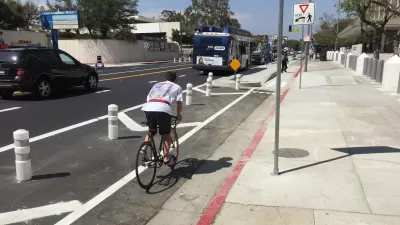I wasn't even in Los Angeles yesterday, and for once I'm glad. Everything from my Facebook feed to the morning headlines told me that traffic on the Westside yesterday afternoon was so awful that only a parade of obscenities accompanied by words like "cluster" and "show" would have sufficed to describe it. Hardened locals were driven nearly to tears behind the wheels of their unmoving cars. The president was in town.
I wasn't even in Los Angeles yesterday, and for once I'm glad. Everything from my Facebook feed to the morning headlines told me that traffic on the Westside yesterday afternoon was so awful that only a parade of obscenities accompanied by words like "cluster" and "show" would have sufficed to describe it. Hardened locals were driven nearly to tears behind the wheels of their unmoving cars.
The president was in town.
This happens every time a president visits, and it doesn't matter which party is in power. The wealthy neighborhoods of the Westside are, understandably, fertile fundraising grounds, whether it's W., Obama, or whomever else is in the White House. So when he visits, the president first does a little business in the city during the day and then, when evening comes, up come the barriers and traffic breaks and the motorcade heads to the hills. This can last for hours.  For what gain, then, does the president tie up a few hundred thousand commuters? ONE. MILLION. DOLLARS.
For what gain, then, does the president tie up a few hundred thousand commuters? ONE. MILLION. DOLLARS.
That's right. Obama raised $1 million at his dinner last night. Most of that money is going to the DNC. But just to put it in perspective, that's about 1/500th of the cost of the average presidential campaign these days.
I'm writing mainly to illustrate the absurdities of American campaign finance and not about urbanism per se, but doing so through the perspective of urbanism is as good a method as any. What we need to realize here is that in the course of following the rules of American campaign finance, President Obama actually cost the city of Los Angeles far more than he reaped. (And obviously Los Angeles is not the only city that bears this burden.)
Let's set aside the surely staggering cost of security, police, Highway Patrol, bomb squads, etc. (which cities are technically obligate to spend in return for receiving federal funds). Conservatively, if 200,000 Westsiders suffered an average of an extra hour of congestion yesterday afternoon, then according to the Texas Transportation Institute's estimate (pdf) that an hour in L.A. traffic is worth $15 per person, then raising Obama's lousy $1 million cost the citizens of Los Angeles a collective $3 million.
Of course, the funding streams that feed into commuters' wallets have nothing to do with those that feed into a president's fundraising account. But, even so, if Obama had stayed home and gotten his $1 million from, say, a federally administered pool of campaign money, then Los Angeles would be $3 million richer and (slightly) less neurotic.
As I said, this piece is more about campaign finance than about urbanism. But if ever you need reason to consider campaign finance reform, all you need to do is imagine all those cars backed up on Wilshire, Sunset, Santa Monica, and the 405 while black limousines speed towards Bel Air.

Maui's Vacation Rental Debate Turns Ugly
Verbal attacks, misinformation campaigns and fistfights plague a high-stakes debate to convert thousands of vacation rentals into long-term housing.

Planetizen Federal Action Tracker
A weekly monitor of how Trump’s orders and actions are impacting planners and planning in America.

San Francisco Suspends Traffic Calming Amidst Record Deaths
Citing “a challenging fiscal landscape,” the city will cease the program on the heels of 42 traffic deaths, including 24 pedestrians.

Defunct Pittsburgh Power Plant to Become Residential Tower
A decommissioned steam heat plant will be redeveloped into almost 100 affordable housing units.

Trump Prompts Restructuring of Transportation Research Board in “Unprecedented Overreach”
The TRB has eliminated more than half of its committees including those focused on climate, equity, and cities.

Amtrak Rolls Out New Orleans to Alabama “Mardi Gras” Train
The new service will operate morning and evening departures between Mobile and New Orleans.
Urban Design for Planners 1: Software Tools
This six-course series explores essential urban design concepts using open source software and equips planners with the tools they need to participate fully in the urban design process.
Planning for Universal Design
Learn the tools for implementing Universal Design in planning regulations.
Heyer Gruel & Associates PA
JM Goldson LLC
Custer County Colorado
City of Camden Redevelopment Agency
City of Astoria
Transportation Research & Education Center (TREC) at Portland State University
Jefferson Parish Government
Camden Redevelopment Agency
City of Claremont






























